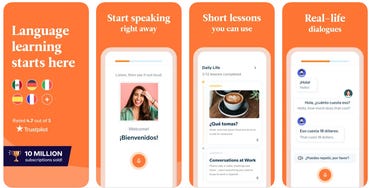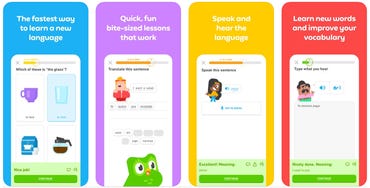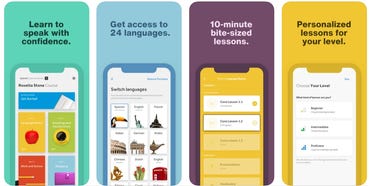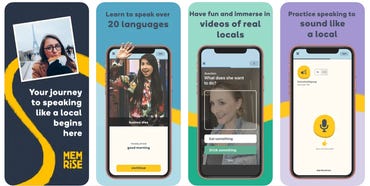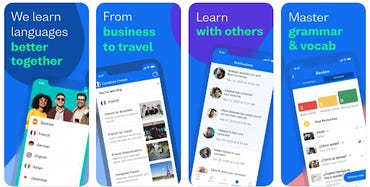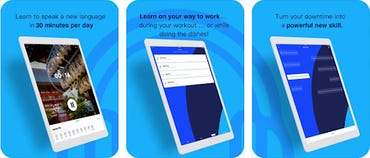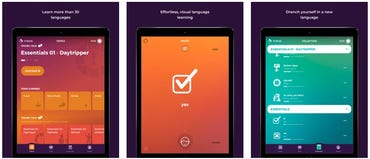[ad_1]
Are you considering learning a second language? Thanks to technology, there’s never been a better time to master another language. Gone are the days of signing up for a class or buying textbooks. Now all you need is your smartphone.
There are dozens of outstanding language learning apps to choose from. But the hard part is narrowing it down to the best one for you. We looked at all of the top language learning apps on the market to see which really offer the best features for the price and narrowed it down to our seven favorites. No matter what your language goals or your learning style, there’s an app here that meets your needs.
Best overall language learning app
Price: $13.95 per month
Babbel has quickly become one of the most popular language-learning apps, with more than 10 million subscriptions sold. The curriculum is designed by linguists, combining traditional learning with innovative and interactive lessons. The app uses evidence-based, proven teaching methods and offers learning in a variety of formats.
Babbel has several different pricing structures to choose from. First, their monthly subscription method allows you to pay every month, three months, six months, or year. The longer your subscription, the less you’ll pay per month. There’s also a 20-day money-back guarantee in case you sign up and don’t love it.
Babbel has excellent reviews. With more than 257,000 ratings, the app has an average of 4.7 of 5 stars. The developer goes out of their way to respond to customer reviews, both positive and negative ones.
Pros:
- Interactive dialogue to help with pronunciation.
- 10-15 minute lessons to make it flexible with your schedule.
- Unique and immersive teaching style.
Cons:
- Few features to keep you motivated.
- Similar format to traditional learning, which isn’t right for everyone.
- Less content for less popular languages.
Best free language learning app
Price: Free
Duolingo has become the most popular language-learning app today, and for good reasons. The app offers game-like lessons to help you learn more than 35 different languages. The app uses science-based teaching methods to help you learn. Lessons are personalized to your learning style, and you tackle a variety of language skills.
Lessons are progressive, meaning each one builds off the one before it. You can’t move on until you’ve unlocked each level by answering enough correct answers. And if you spend too much time away from the app, it will have you repeat certain lessons to ensure your skills haven’t gotten rusty.
Duolingo’s reviews speak for themselves. The app has more than 1.2 million ratings on the app store, with an average rating of 4.7 of 5 stars.
Duolingo consistently earns the App Store’s Editor’s Choice award.
Pros:
- Free language learning.
- Well organized, progressive lessons.
- Features designed to keep you motivated.
- Lessons can be done in just a few minutes.
Cons:
- Less content for less popular languages.
- Requires you to learn topics in a certain order.
- Limited opportunity for real-world practice
Best for immersive language learning
Price: $35.97 for three months, $95.88 for 12 months, or $179 for lifetime access.
Rosetta Stone has been a leader in language learning for 25 years, so it should come as no surprise that it makes our list of the best language learning apps today. The app allows you to choose from dozens of different languages and build a curriculum plan that best fits your learning style. You can practice speaking the language with audio recognition to determine if you’re on track. You can also use audio-based learning when you’re on the go. The stories feature also allows you to learn by reading along with native speakers.
Rosetta Stone has modernized its pricing structure to make it more competitive with other language learning apps. Rather than paying a set price for each language, you can now pay for a subscription-based plan. 3 and 12-month plans offer monthly rates ranging from $7.99 and $11.199. But for committed learners, you can pay $179 for lifetime access to unlimited languages.
Rosetta Stone’s app has excellent reviews. With roughly 160,000 reviews on the App Store, the app has an average rating of 4.8 of 5 stars, making it one of the most highly-rated language learning apps on the market.
Pros:
- Various pricing options.
- Personalized lesson plan.
- Proven teaching method.
Cons:
- Limited instruction or explanations.
- Sometimes repetitive lessons.
- Doesn’t prepare you for conversational use.
Best for learning real-world phrases
Price: $8.99 per month for a month-to-month plan, $7.50 per month for an annual plan, and $139.99 for lifetime access.
Have you ever used a language learning app and felt like the phrases you practiced were ones you’d never use in real life? Memrise addresses that problem by designing lessons filled with real-world phrases. In fact, you’re learning from native speakers who are speaking in real-life situations. You can learn new words, watch videos of native speakers, and practice using real-world phrases.
Memrise Pro has three different pricing options. The month-to-month plan is available for just $8.99 per month. If you upgrade to the annual plan, it comes out to just $7.50 per month. Finally, you can purchase lifetime access for $139.99, which is the equivalent of paying for the monthly plan for just over a year.
Memrise’s app has excellent user reviews. With more than 175,000 reviews, the app has an average rating of 4.8 of 5. It also has an Editor’s Choice Award for being one of the best language learning apps.
Pros:
- Designed to help you learn real-world phrases.
- Game elements to make learning more fun.
- Lots of content for each language.
Cons:
- Exercises can be repetitive.
- Varying quality of user-created content.
- Focused on vocabulary, not grammar.
Best for goal-oriented learning
Price: Free for basic, €9,99 per month for Premium, €10,99 per month for Premium Plus.
Busuu takes a goal-oriented approach to language learning by allowing you to create study goals and a study plan to help you achieve those goals. The app uses topic-based lessons to help you learn vocabulary and increase your conversational skills gradually. Each lesson builds upon the previous one to help reinforce your memory, helping you reach fluency more quickly.
Busuu has three different plan options to choose from. The free Basic plan gives you access to one language and a limited number of features. The Premium plan also allows for just one language but allows you to unlock more features. Finally, the Premium Plus plan gives you access to up to 12 languages and all app features. Monthly, 12-month, and 24-month plans are available, with the longer plans being cheaper per month.
Though Busuu doesn’t have the number of users as some of the more popular language learning apps, it still has excellent reviews by those who have used it. The app has roughly 63,000 reviews, with an average rating of 4.7 of 5 stars.
Pros:
- Interaction with native speakers.
- Goal-oriented approach.
- Well-structured courses.
Cons:
- Limited pronunciation, reading, and listening comprehension exercises.
- Sometimes monotonous exercises.
- Small language selection.
Price: $19.95 per month.
Unlike other language learning apps that have on-screen interactive games, Pimsleur is specifically designed to help you learn by listening. Pimsleur uses an audio format, meaning it’s easy to learn on the go. And because you listen to native speakers, you help learn vocabulary and listening comprehension quickly.
Pimsleur’s premium plan is a bit more expensive than its competitors. After a 7-day free trial, you’ll pay $19.95 per month to learn a language. The good news is that Pimsleur claims you can learn a new language in just 30 days.
The Pimsleur app doesn’t have a huge user base yet, but those that use it give it excellent reviews. With about 4,400 reviews on the app store, the app has an average rating of 4.7 of 5 stars.
Pros:
- Easy to learn while on the go.
- Learn from native speakers.
- 50 languages to choose from.
Cons:
- Expensive subscription.
- Limited visual learning.
- Doesn’t help with reading or writing skills.
Price: $9.99 per month or $69.99 per year.
Drops has a unique approach to language learning that is perfect for visual learners. Drops is specifically designed to help you build vocabulary. It does that by pairing images and matching games with teaching methods. The app’s audio helps you to learn pronunciation as you read the words. Drops has an interesting technique where it limits your learning to five minutes per day. According to the app, this prevents you from overwhelming yourself or trying to learn too much at once. And yes, this five-minute limit applies even with the paid plan.
Drops has simple subscription methods to choose from. You can pay $9.99 per month for a month-to-month plan. Alternatively, you can pay $69.99 for an annual plan — this comes out to less than $6 per month.
Drops has an Editor’s Choice Award on the app store and has excellent reviews from its users. With more than 50,000 reviews, the app has an average rating of 4.8 of 5 stars.
Pros:
- Good for visual learners.
- Learn in a fun and engaging way.
- Many languages and topics to choose from.
Cons:
- Only focused on vocabulary.
- Limited to five minutes per day.
- Doesn’t prepare you for real-world use.
How did we choose these apps?
When seeking out the best language learning apps of 2021, we looked for those that combine unique features with proven teaching methods. There’s an endless number of apps available to help you master a new language.
And to stand out, an app must have something new to offer. Well, all of those on our list do, whether it’s their teaching approach, interactive features, or a one-of-a-kind approach.
Factors we considered when choosing the best apps to include:
Which is the right app for you?
With all of the language learning apps available on the market today, it can be difficult to know which one is right for you. After all, the last thing you want is to pay for a subscription to a dozen different apps on your search for the right one.
First, decide ahead of time what language you want to learn. Each app has a limited number of languages available. Some languages, such as Spanish, French, and German, are likely to be available on any app. But other less common languages might be harder to find. Knowing what language you want to learn will help you to narrow down the app.
It’s also important to consider how you learn best. Some language learning apps take a more traditional approach to teaching, while others use more unique methods for alternative learners. Do you learn best by reading words on a screen? Hearing a teacher explain a concept? Or perhaps just hearing real-world use of a language and picking it up as you go? Each app is best suited to certain learning styles.
Finally, consider your ultimate goal with your language studies. If you enjoy learning languages and don’t anticipate using them in the real world, then you may have a greater variety of apps to choose from. But if you’re planning to use what you learn in real-world situations such as travel or interacting with native speakers, then focus on an app that caters to that purpose.
Do language learning apps really work?
The short answer is: Yes.
One study found that 59% of language app users improved their oral proficiency in another language by at least one sublevel on the proficiency scale of the American Council on the Teaching of Foreign Languages.
Can you become fluent with language learning apps?
You can learn everything you need to know from a language app to become fluent, but it’s most successful when paired with consistent and real-world use of the language.
What is the best language learning app?
While there are many language learning apps to choose from, Babbel has risen to the top thanks to its teaching methods, interactive dialogue, and personalization for each user.
What is the best free language learning app?
Duolingo is our favorite free language learning app because it’s easy to use, offers a wide variety of languages, and has excellent customer reviews.
Are there alternatives worth considering?
The 10 language learning apps we discussed in this comparison are some of the most popular on the market. Each one has a unique approach to language learning and excellent feedback from users. But these 10 certainly aren’t the only options on the market, and several other apps are worth considering. Other popular language learning apps include:
-
Mondly: Unlike some other apps, Mondly allows you to use it from your native language.
-
TripLingo: This app is perfect for travelers. Tell the app where you’re traveling to, and it will provide you with the key phrases you’ll need to know.
-
HelloTalk: Helping you learn another language by chatting with native speakers and joining in live classes
-
Mango: One of the most robust language-learning apps, with more than 70 languages to choose from
-
Beelinguapp: Designed for learning by reading your favorite books in another language alongside your native language
- Lirica: Designed for learning Spanish and German through music
Source link
 Tech News code
Tech News code
